Flooring makers stress cleaning and resiliency
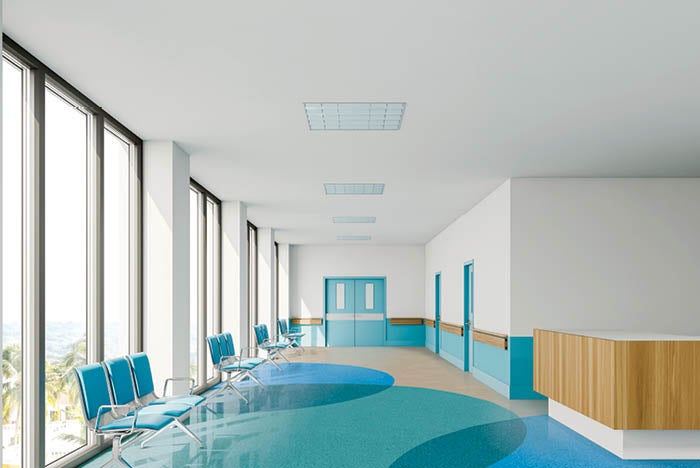
Hospitals pose many challenges to manufacturers of flooring products. One is the wide array of spaces to consider — from operating suites to patient rooms to commercial kitchens. Each area has its own challenges, and it’s important to ask the right questions to ensure that proper flooring is selected and installed.
Priorities for any health care space is that the flooring system is easy to clean and can withstand the use and abuse specific to the environment.
Flooring solutions must support both patients and staff with physical and visual comfort, while being durable and easily maintained for optimal infection control. Many stakeholders must weigh in, and each type of medical care requires a different approach to flooring specification in each space.
Design is an important attribute as well. Balancing the required functionality and selecting a finish that fulfills a vision may be challenging.
“Resilient flooring can contribute to biophilic design by replicating colors, textures and imagery found in nature,” says Yon Hinkle, vice president for product management at Armstrong Flooring, Lancaster, Pa. “It also can help delineate specific areas and guide visitors and patients along the right path through colorful inlays or other design elements.”
Key attributes
Key attributes in demand include safety, comfort, acoustics, mobility, easy maintenance, infection control and aesthetics. Flooring needs to provide stability and traction for foot and wheeled traffic to minimize the risk of injury. It also needs to be hygienic with a watertight installation and be compatible with facility-approved disinfectants used for environmental cleaning.
Flooring plays an important role in the functionality and performance of health care spaces, according to Kieren Corcoran, director of performance markets at Patcraft, Cartersville, Ga. “For example, if an area is used as an aseptic space, seams must be limited. Within ambulatory care facilities, we see hard surfaces used more broadly for disinfectant purposes, where carpet was common prior to the pandemic. This can create a challenge for acoustics, which is why it is important to consider luxury vinyl tile (LVT) with a thicker profile, for example a 4-millimeter (mm) LVT product, which can aid in sound absorption.”
Tom Hume, vice president of segment sales for health care at Interface, Atlanta, sees more sheet flooring being used holistically throughout hospitals due to its disinfection protocols and sterile perception. “We’re seeing hospitals opt to use sheet flooring throughout all clinical areas, especially as the pandemic has increased the need for critical, sterile environments for patients.”
Thomas Ricciardelli, president of SelecTech, Avon, Mass., sees a growing need for flooring products that offer static control. “There are many documented cases where static shocks have created problems in hospitals. As more electronics are used in this environment, these issues are increasing. Static control flooring can provide benefits.” He says more information is available from the Electrostatic Discharge Association, Rome, N.Y., which has a flooring committee.
The growth of small, off-site facilities is having an impact on flooring specification and installation as well. Hume says that LVT and carpet tile are the most specified flooring types at these locations, which have limited cleaning staff compared to large hospitals. “These spaces rarely have an in-house infection control team, so Interface flooring categories allow local care facilities to clean and maintain their flooring products without further outsourcing.”
Construction of off-site facilities has grown in recent years as hospital systems seek to bring their health care services to areas beyond their main campus, says Kathy Griffel, director of health care at Mannington Commercial, Calhoun, Ga. “Typically, product requirements are similar to the main hospital, as most of the same functions are performed. Aesthetics, however, are often differentiated, resulting in a locally influenced, softer hospitality palette, thus creating a more welcoming environment.”
Features and benefits
Flooring products recently introduced to the health care market incorporate many of the aforementioned features as well as a kaleidoscope of colors and green construction initiatives.
For example, Armstrong Flooring has introduced MedinPure, a polyvinyl chloride (PVC)-free homogeneous sheet product that incorporates a patent-pending formulation, which coordinates PVC-free weld rods for aseptic areas. The palette is comprised of aqueous blues, vibrant greens and complementary tones, which draw on biophilic inspiration. “Its Diamond 10 Technology coating is a no-polish, low-maintenance solution that offers scratch, stain, scuff and slip resistance,” Hinkle says.
Armstrong also has introduced Exchange luxury flooring, which features soft pastels and rich, saturated tones that complement a visual texture to add depth and interest. The collection includes two distinct, yet compatible, designs. “System Gradient features a subtle ombre effect across a 6-by-36-inch plank in a soft color palette, mimicking the flow of light through space and creating a sense of clean comfort,” Hinkle says. “Also available in a 6-by-36-inch plank, System Static offers consistent saturation of color in a variety of neutrals and bright pops of color that can stand alone or be used as a collaborative accent.”
Patcraft has introduced Local Reserve, which offers appearance retention, ease of installation and moisture-control features. The collection’s watertight, tongue-and-groove construction provides dimensional stability and requires no acclimation prior to installation. “This is a good flooring solution for interiors with potential for heavy rolling loads or static equipment, as it has a 2,500-pound-per-square-inch capacity and is backed by an indentation warranty,” Corcoran says. “For areas prone to scratch concerns, Local Reserve offers Patcraft’s ExoGuard+ top coat. These features make it suitable for many hospital spaces, including waiting areas, offices and corridors.”
American Biltrite, Sherbrooke, Canada, has introduced an LVT called Sonata Elements: an 18-by-36-inch tile with a 22-mil wear layer and a polyurethane surface treatment that makes it easy to clean and disinfect. “What makes this LVT unique is its striated textile visual and how the collection was designed to color coordinate and allow unlimited flooring patterns such as wayfinding and social distancing indicators,” says Catherine Del Vecchio, vice president of marketing for American Biltrite’s flooring division. The line is made of five all-over neutral colors, which declines into five tone-on-tone neutrals. The initial five neutrals also are transformed in chromatic gradient tone-on-tone patterns, providing the right amount of accent color.
“Biophilic design has been proven to provide positive health care outcomes, and Mannington’s recent launch of Bloom heterogeneous sheet vinyl was designed with this influence in mind,” Griffel says. In addition, the sheet format provides infection control. It’s available in multiple widths, which allows for seams to be eliminated or minimized.
“Operating rooms have always been a challenge because floor performance needs are more demanding, particularly in specialty operating rooms,” Griffel says. “Mannington’s new BioSpec Armor homogeneous sheet was engineered to improve flooring performance in these demanding environments.”
Mohawk Group, Calhoun, Ga., recently introduced the True Collection of rubber sheet and tile, which comes in a wide range of colors and offers resilience, slip resistance and ease of maintenance, according to Elizabeth Bonner, director of design. The collection features Ngrain technology, a treatment that allows the coating to penetrate and seal the product, making it easy to clean. No special maintenance procedures, such as sealing or waxing, are required. “The 3-mm product is available in 5-by-50-foot sections,” Bonner says. “It also is quiet and comfortable underfoot. True Rubber Flooring products are part of the Living Building Challenge Declare Program, which is a green initiative.”
The newest flooring products available from SelecTech Inc. are based on the company’s FreeStyle interlocking system. Two new versions, FreeStyle BioLock and FreeStyle ESD Designer Series, are geared to the health care market. Both versions can be installed on top of old flooring, so they are less disruptive to hospital operations. “The BioLock surface has all the features needed for hospital settings with seams that can be sealed for infection control,” Ricciardelli says. “The ESD Designer Series has those same features and offers static control.”
Lonseal, Carson, Calif., offers Lonwood Natural flooring, which is suitable for hospital settings. It has a soft and gentle pattern and smooth-surface wood colorations that are often used for wayfinding and design accents, according to Dottie Greaney, Western U.S. sales manager for Lonseal. “Lonwood is resilient, cushioned flooring and is easier on the knees than vinyl composition tile or LVT,” she says. “It also features a Topseal urethane finish. Topseal is UV-cured for reduced use of solvents and lower VOC emissions during manufacturing.”
Ecore Rx flooring from Ecore, Lancaster, Pa., features the company’s proprietary “itsTRU” technology, which fusion bonds a 2-mm resilient sheet product to a 5-mm vulcanized composition rubber (VCR) backing. The density and properties of the VCR backing meet general performance requirements related to static load, dynamic load and roller mobility required by hospitals. “The result is a hybrid resilient floor that provides easy maintenance combined with enhanced acoustics, ergonomics and safety benefits for patients and staff,” says Mark Huxta, director of health and wellness.
Forbo Flooring, Hazleton, Pa., has developed a series of flooring solutions called Forbo EZvations, which combine the performance of Marmoleum with puncture-proof ArmorCove technology. “For monolithic installations, such as surgical areas in hospitals, Forbo Marmoweld ETU, color-matched paste weld is the preferred seaming method,” says Casey Johnson, director of health care business development for North America. “The Forbo 100 Adhesive System speeds up installation time, allowing for areas to be turned over upon completion via our proprietary, immediate occupancy installation system.”
Interface recently launched its first high-performance vinyl sheet. “Featuring a monolithic aesthetic and color options that align with the needs of health care end users and current segment trends, this vinyl sheet provides durability and long-lasting beauty,” Hume says. The company now provides a full suite of flooring options: nora rubber, carpet tile, LVT and vinyl sheet.
Tarkett North America, Solon, Ohio, offers Tarkett iQ sheet and tile collections that feature a homogeneous material that can be perpetually restored to like-new condition. It is durable enough to withstand harsh hospital environments and requires no stripping or refinishing for the life of the floor, according to Margaret Bartholomew, health care marketing manager. “In areas where soft surfaces are preferable, the Garden Walk Collection offers a broad selection of biophilic patterns, specifically designed to support senior living and memory-care patients.”
Stonhard, Maple Shade, N.J., offers resinous flooring systems that are poured in place. Stonres RTZ and Stonres STR are suitable for sterile areas and operating rooms because they provide comfort underfoot, stand up to high impact and chemicals, and improve infection control. Stonshield QBT is textured and slip-resistant, which is ideal for bathrooms. “For patient rooms, we offer both Stonhard and our decorative brand, Liquid Elements,” says Kyle Tierney, technical services manager. “Design options are wide ranging, and our flooring products provide for a quiet and comfortable healing space.”
Safe, hygienic environments
Manufacturers state that future flooring innovations will continue to promote safe, hygienic health care environments. In the area of sustainability, the development of PVC-free products will continue. Demand for information related to product ingredients and environmental impact will increase as well.
Hinkle predicts that flooring design will remain a top priority for health care facilities. “Visuals are moving away from the cold and clinical and toward friendly, reassuring spaces that put the patient experience front and center. We also see a greater opportunity for flooring customization to help create a cohesive brand experience within a health care network.”
Neal Lorenzi is a freelance writer and regular contributor based in Mundelein, Ill.
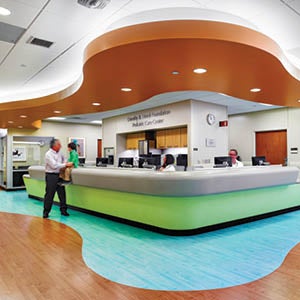
FINDING THE WAY
Lonwood Natural has a soft and gentle pattern, and colors that are often used for wayfinding and design accents. Lonseal
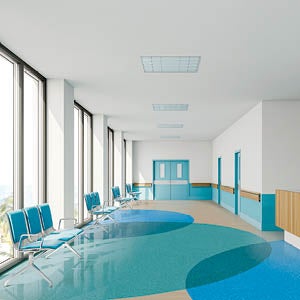
FREE TO CHOOSE
MedinPure PVC-free sheet flooring includes coordinating PVC-free weld rods for aseptic areas. Armstrong Flooring
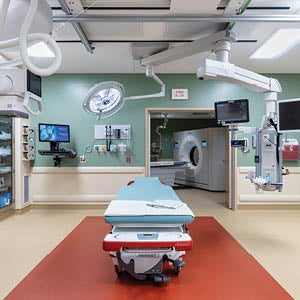
SAFE CHOICE
iQ collections deliver infection control, don’t need to be stripped or refinished, and are available in static-conductive and static-dissipative options to protect patients, staff and equipment. Tarkett North America
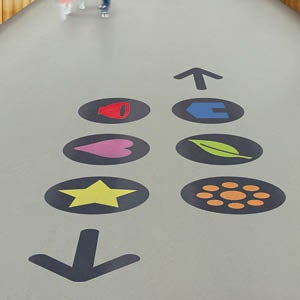
LOOK OUT BELOW
Design techniques such as color-blocking Marmoleum and waterjet flooring symbols help guide traffic and provide subtle social distancing cues. Forbo Flooring
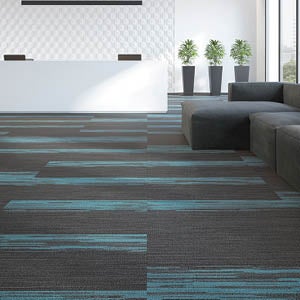
DECEPTIVELY ATTRACTIVE
Sonata Elements provides the look of carpet tiles in a luxury vinyl tile, with an aluminum oxide polyurethane surface treatment that offers scratch and stain resistance, no wax, and ease of cleaning and disinfection. American Biltrite
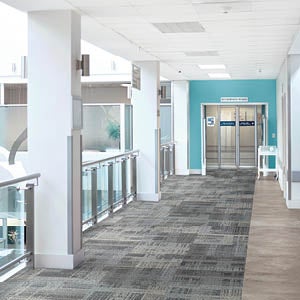
HYBRID SOLUTION
Criterion Classic LVT and nora rubber flooring are natural companions and can be combined to provide a high-performance, transition-free flooring solution. Interface
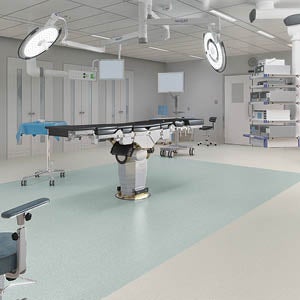
HEAVY DUTY
BioSpec Armor, a new sheet flooring product, is resistant to gouging, tearing, staining and indentation, making it suitable for areas that experience heavy traffic, and rolling and static loads. Mannington Commercial
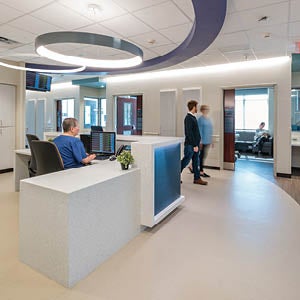
REAL WORLD
The Methodist Mansfield Medical Center NICU in Mansfield, Texas, features Infinity Rx and Strait Rx, which incorporate Ecore’s “itsTRU” technology. Ecore
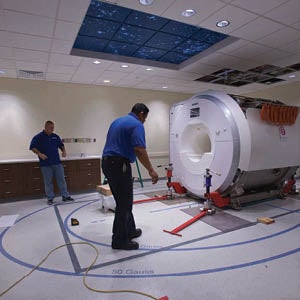
IN THE FIELD
FreeStyle BioLock tiles are installed at an MRI center at Brigham & Women’s Hospital, Boston. SelecTech Inc.
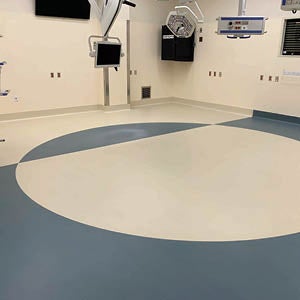
SMOOTH OPERATOR
Suitable for operating rooms, Stonres RTZ is a resilient urethane flooring system that is stain and impact resistant, and provides acoustic efficiency and comfort underfoot. Stonhard
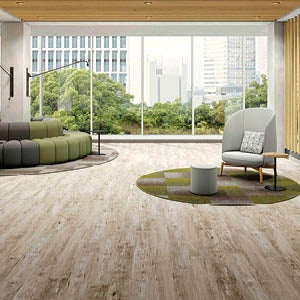
SAFE AND STABLE
Local Reserve features a watertight, tongue-and-groove construction that offers dimensional stability in hospitals. Patcraft

HEALING NATURE
The Medella Collection draws inspiration from biophilic design to advance healing and productivity in health care interiors. Mohawk Group




